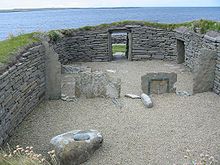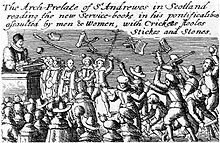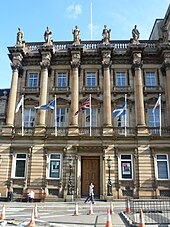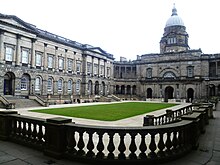Historia Scotiae
Historia Scotiae nobis nota saeculo primo coepit, cum actores Imperii Romani advenirent, provinciá Romaná Britanniae ad septentriones usque ad Vallum Antoninum attingentibus. Ad septentriones patebat Caledonia, regio a Pictis habitata, quorum rebelliones legiones Romanas ad Vallum Aelium reppulerunt. Praedatores Godeli? Scoti appellati, militibus imperii ad ultimum a totá Britanniá avocatis, colonias in Scotia occidentali et Cambria deducere coeperunt. Ante aevum Romanum, Scotia praehistorica aevum neolithicum circa 4000 a.C.n., aevum aeneum circa 2000 a.C.n., aevumque ferreum circa 700 a.C.n. intraverat.



Dál Riata, regnum Godelicum, in occidentali Scotiae litore saeculo sexto conditum est. Proximo autem saeculo, missionarii Christiani Pictos, antea paganos, ad Christianitatem Celticam duxerunt. Post missionem Gregorianam Anglosaxonicam, Nechtan, rex Pictorum, plurimos usus Celticos pro ritu Romano abolevit, gratiam Godelicam? in suo regno circumscribens, bellumque cum Angliana Northumbria evitans.[1] Saeculo octavo exeunte, incursiones Viccingorum coeperunt, unde Picti et Godelici? sumultates inter se finierunt; sese saeculo nono coniunxerunt, regnum Scotorum constituentes.
Regnum Scotorum sub Domu Alpina coaluit, cuius cives inter se per successiones controversas pugnabant. Milcolumbo II, ultimo rege Alpino, saeculo undecimo ineunte sine prole mortuo, regnum per suum filiae filium domui Dunkeldianae (vel Canmore) translatum est. Alexander III, ultimus rex Dunkeldianus, anno 1286 mortuus est. Sola heres erat Margareta puella Norvegica, neptis infans, quae ipsa quattuor post annos obiit. Anglia, Eduardo I rege malleo Scotorum appellato, in Scotos iterum atque iterum bella inferebat, cum regnum vicissim inter domus Balliolensis et domus Brus vindicaretur. Ultima autem Scotiae victoria regnum sui iuris ac prorsus libera effecit.



























Davide II mortuo sine prole, Robertus II, sororis filius, domum Stuartensem constituit, quae Scotiam sine vindicatione tria saecula regnabant. Iacobus VI, rex Stuartensis Scotorum, regnum Anglicum anno 1603 hereditate excepit, et reges reginaeque Stuartenses ambo regna libera regnabant donec Actus Unionis anno 1707 bina regna in novam civitatem sui iuris misceret, quae regnum Magnae Britanniae appellatur.[2][3][4] Anna, quae usque ad annum 1714 regnavit, fuit ultima monarcha Stuartensis. Ex 1914, successio monarcharum Britannicarum domuum Hanoverae et Saxe-Coburg et Gothae (Windsor) quia progenies sunt Iacobi VI et I domus Stuartensis.
Scotia tempore illuminismi Scotici et conversionis industrialis facta est una ex Europaeis commercii, intellectus, industriaeque potestatibus. Deinde, defectio suae oeconomiae post secundum bellum mundanum praesertim acris erat. Recentioribus autem decenniis, Scotia quandam renascentiam industriae culturaeque experta est, partim a ministeriis pecuniariis, partim a lucris gasii et petrolei maris septentrionalis sustentam. Ex annis 1950, nationalismus res politica magni momenti factus est, seriis disputationibus de libertate Scotica atque in referendo anno 2014 de abitu ab unione Britannica habitis.
Nexus interni
Homines
recensere- Gnaeus Iulius Agricola
- Iacobus Matthaeus Barrie
- Iacobus Boswell
- Robertus Burns
- Thomas Carlyle
- Arthurus Conan Doyle
- David Hume
- Macbethus
- Maria I, regina Scotorum
- Iacobus Clerk Maxwell
- Gualterus Scott
- Adam Smith
- Robertus Ludovicus Stevenson
- Iacobus Watt
- Guillelmus Wallaceus
Res
recensereNotae
recensere- ↑ "Scots and Picts". BBC Education Scotland.
- ↑ "Uniting the kingdom?". National Archives
- ↑ "Union of Crowns to Union of Parliaments: The Union of the Parliaments 1707". Education Scotland.
- ↑ Union with England Act 1707, Article II.
Bibliographia
recensereConspectus et libri referendi
recensere- Oxford Dictionary of National Biography. 2004. Editio interretialis.
- Devine, T. M. 1999. The Scottish Nation, 1700–2000. Penguin books.
- Devine T. M., et Jenny Wormald, eds. 2014. The Oxford Handbook of Modern Scottish History.
- Donaldson, Gordon, et Robert S. Morpeth. 1977. A Dictionary of Scottish History.
- Donnachie, Ian, et George Hewitt. 2001. Dictionary of Scottish History.
- Houston, R. A., et W. Knox, eds. 2001. New Penguin History of Scotland. ISBN 0-14-026367-5.
- Kearney, Hugh F. 2006. The British Isles: a History of Four Nations. Ed. secunda. Cantabrigiae: Cambridge University Press.
- Keay, John, et Julia Keay. 2001. Collins Encyclopedia of Scotland. Ed. secunda.
- Lenman, Bruce P. 2009. Enlightenment and Change: Scotland 1746–1832. Ed. secunda. The New History of Scotland Series. Edimburgi: Edinburgh University Press. ISBN 978-0-7486-2515-4.
- Lynch, Michael, ed. 2007. The Oxford Companion to Scottish History. Nonnullae paginae.
- Mackie, J. D. 1991. A History of Scotland. Penguin books. ISBN 0-14-013649-5.
- Mackie, J. D., Bruce Lenman, et Geoffrey Parker. 1984. A History of Scotland. Amazon.com.
- Maclean, Fitzroy, et Magnus Linklater. 2001. Scotland: A Concise History. Ed. secunda. Amazon.com.
- McNeill, Peter G. B., ry Hector L. MacQueen, eds. 1996. Atlas of Scottish History to 1707. The Scottish Medievalists and Department of Geography.
- Magnusson, Magnus. 2000. Scotland: The Story of a Nation.
- Mitchison, Rosalind. 2002. A History of Scotland. Ed. tertia. Routledge, Editio interretialis.
- Nicholls, M. 1999. A History of the Modern British Isles, 1529–1603: the Two Kingdoms. Wiley-Blackwell.
- Panton, Kenneth J., et Keith A. Cowlard. 1996. Historical Dictionary of the United Kingdom. Vol. 2: Scotland, Wales, and Northern Ireland.
- Paterson, Judy, et Sally J. Collins. 2000. The History of Scotland for Children.
- Pittock, Murray. 2003. A New History of Scotland. ISBN 0-7509-2786-0.
- Smout, T. C. 1998. A History of the Scottish People, 1560–1830. Fontana.
- Tabraham, Chris, et Colin Baxter. The Illustrated History of Scotland. Amazon.com.
- Watson, Fiona. 2003. Scotland; From Prehistory to the Present. Tempus.
- Wormald, Jenny. 2005. The New History of Scotland. Amazon.com.
Studia praecipua
recensere- Buchan, James. 2003. Capital of the Mind: How Edinburgh Changed the World. Londinii: John Murray.
- Colley, Linda. 1992. Britons: Forging the Nation 1707–1837. Portu Novo: Yale University Press.
- Cooke, Anthony. 2010. The Rise and Fall of the Scottish Cotton Industry, 1778–1914. Manchester University Press.
- Devine, T. M. 2003. Scotland's Empire 1600–1815. Allen Lane, Harmondsworth.
- Duncan A. A. M. 2004. The Kingship of the Scots 842–1292: Succession and independence. Edimburgi: Edinburgh University Press.
- Ferguson, W. 1977. Scotland's Relations with England: A Survey to 1707. Saltire Society.
- Finlay, Richard. 2004. Modern Scotland 1914–2000. Profile.
- Hamilton, David. 1981. The healers: a history of medicine in Scotland. Pelican.
- Harvie, Christopher. 2004. Scotland and Nationalism: Scottish Society and Politics 1707–1977. Ed. quarta. Routledge
- Hearn, J. 2000. Claiming Scotland: National Identity and Liberal Culture. Edimburgi: Edinburgh University Press.
- Macdougall, N. 2001. An Antidote to the English: the Auld Alliance, 1295–1560. Tuckwell Press.
- Pittock, Murray. 2008. The Road to Independence? Scotland since the Sixties. Nonnullae paginae.
- Smout, T. C. 1963. Scottish Trade on the Eve of the Union, 1660–1707. Oliver & Boyd.
- Smout, T. C. 1993. Scotland Since Prehistory: Natural History and Human Impact. Scottish Cultural Press.
Cultura et religio
recensere- Anderson, R. D. 1995. Education and the Scottish People, 1750–1918. Oxoniae: Oxford University Press.
- Browen, Ian, ed. 2006. The Edinburgh History of Scottish Literature. 3 vol.
- Brown, Callum G. 1997. Religion and Society in Scotland since 1707.
- Burleigh, J. H. S. 1962. A Church History of Scotland.
- Daiches, David. 1982. A Companion to Scottish Culture. Editio interretialis.
- Dingwall, Helen M. 2005. Famous and flourishing society: the history of the Royal College of Surgeons of Edinburgh, 1505–2005. (2005) ISBN|0-7486-1567-9.
- Ferguson, William. 1998. The Identity of the Scottish Nation: An Historic Quest. Editio interretialis.[nexus deficit]
- Glendinning, Miles, Ranald MacInnes, et Aonghus MacKechnie. 1996. A History of Scottish Architecture: From the Renaissance to the Present Day. Editio interretialis[nexus deficit].
- Hardy, Forsyth. 1990. Scotland in Film. Editio interretialis[nexus deficit].
- Harris, Nathaniel. 2000. Heritage of Scotland: A Cultural History of Scotland and Its People. Facts on File.
- Lawrence, Christopher. 2005. Rockefeller money, the laboratory, and medicine in Edinburgh, 1919–1930: new science in an old country. ISBN 1-58046-195-6.
- Levack, Brian. 2007. Scottish Witch Hunting: Law, Politics and Religion.
- McDonald, R. A., ed. 2002. History, Literature and Music in Scotland, 700–1560.
- Mackenzie, D. A. 1935. Scottish Folklore and Folklife.
- McEwan, Peter J. M. 1995. Dictionary of Scottish Art and Architecture. Wappingers Falls Novi Eboraci: Antique Collectors Club.
- McNeill, F. Marion. 1989. The Silver Bough. Scottish Folk-Lore and Folk-Belief, 1. ISBN 0-86241-231-5.
- Menikoff, Barry. 2005. Narrating Scotland: the Imagination of Robert Louis Stevenson. ISBN 1-57003-568-7.
- Pelling, Margaret, ed. 2005. Practice of Reform in Health, Medicine, and Science, 1500–2000.
- Petrie, Duncan. 2000. Screening Scotland. BFI.
- Porter, James. 1998. "The Folklore of Northern Scotland: Five Discourses on Cultural Representation." Folklore 109: 1+. Editio interretialis.[nexus deficit].
- Ritchie, Anna, et Graham Ritchie. 1998. Scotland: An Oxford Archaeological Guide. Editio interretialis[nexus deficit].
- Schoene, Berthold. 2007. The Edinburgh Companion to Contemporary Scottish Literature.
- Smith, Bill, et Selina Skipwith. 2003. A History of Scottish Art. Merrell.
- Todd, Margo. 2002. The Culture of Protestantism in Early Modern Scotland.
- Walker, Marshall. 1997. Scottish Literature since 1707.
- Whatley, Christopher A. 2000. Scottish Society, 1707–1830: Beyond Jacobitism, toward Industrialisation.
- Wickham-Jones, C. 2007. Orkney: A Historical Guide. Birlinn.
- Wilson, R., ed. 2005. Building with Scottish Stone. Arcamedia.
- Withers, Charles W. J. 2001. Geography, Science, and National Identity: Scotland since 1520.
Praehistoria et archaeologia
recensere- Ashmore, P. J. 2003. Neolithic and Bronze Age Scotland: an Authoritative and Lively Account of an Enigmatic Period of Scottish Prehistory. Batsford.
- Breeze, D. J. 2006. The Antonine Wall. John Donald.
- Cunliffe, C. 2004. Iron Age Communities in Britain: An Account of England, Scotland and Wales from the Seventh Century BC until the Roman Conquest. Routledge.
- Dixon, N. 2004. The Crannogs of Scotland: An Underwater Archaeology. Tempus.
- Lynch, F. 1997. Megalithic Tombs and Long Barrows in Britain. Osprey.
- Moffat, A. 2005. Before Scotland: The Story of Scotland before History. Londinii: Thames and Hudson.
- Pryor, F. 2003. Britain B.C.: Life in Britain and Ireland before the Romans. Harper Collins.
- Robertson, A. S. 1960. The Antonine Wall. Glasgow Archaeological Society.
- Scarre, C. 2002. Monuments and Landscape in Atlantic Europe: Perception and Society during the Neolithic and Early Bronze Age. Routledge.
- Snyder, C. A. 2003. The Britons. Wiley-Blackwell.
Aevum medium
recensere- Barrow, G. W. S., ed. 1992. Scotland and Its Neighbours in the Middle Ages. Hambleton.
- Barrow, G. W. S., Grant, A., et K. J. Stringer, eds. 1998. Medieval Scotland: Crown, Lordship and Community. Edimburgi: Edinburgh University Press
- Barrow, G. W. S. 2005. Robert Bruce and the Community of the Realm of Scotland. Ed. quarta. Edimburgi: Edinburgh University Press.
- Corning, C. 2006. The Celtic and Roman Traditions: Conflict and Consensus in the Early Medieval Church. Macmillan.
- Duncan, A. A. M. 1989. Scotland: The Making of the Kingdom, The Edinburgh History of Scotland, Volume 1. Mercat Press.
- Forte, A., Oram, R. D., et F. Pedersen. 2005. Viking Empires. Cantabrigiae: Cambridge University Press.
- Hudson, B. T. 1994. Kings of Celtic Scotland. Greenhill.
- Macquarrie, A. 2004. Medieval Scotland: Kinship and Nation. Sutton.
- Maddicott, J. R., et D. M. Palliser, eds. 2000. The Medieval State: Essays presented to James Campbell. Continuum).
- Rollason, D. W. 2003. Northumbria, 500–1100: Creation and Destruction of a Kingdom. Cantabrigiae: Cambridge University Press.
- Smyth, A. P. 1989. Warlords and Holy Men: Scotland AD 80–1000. Edimburgi: Edinnburgh University Press.
- Taylor, S., ed. 2000. Picts, Kings, Saints and Chronicles: A Festschrift for Marjorie O. Anderson. Four Courts.
- Webster, B. 1997. Medieval Scotland: the Making of an Identity. St. Martin's Press.
- Woolf, A. 2007. From Pictland to Alba: 789–1070. Edimburgi: Edinburgh University Press.
- Woods, J. D., et D. A. E. Pelteret, eds. 1985. The Anglo-Saxons, Synthesis and Achievement. Wilfrid Laurier University Press.
- Yorke, B. 2002. Kings and Kingdoms of Early Anglo-Saxon England. Routledge.
- Yorke, B. 2006. The Conversion of Britain: Religion, Politics and Society in Britain c. 600–800. Pearson Education.
Aevum modernum primum
recensere- Dawson, J. E. A. 2007. Scotland Re-Formed, 1488–1587. Edimburgi: Edinburgh University Press.
- Ryrie, Alec. 2006. The Origins of the Scottish Reformation. Manchester: Manchester University Press.
- Wormald, Jenny. 1991. Court, Kirk, and Community: Scotland, 1470–1625. Edimburgi: Edinburgh University Press.
- Buchan, James. 2003. Crowded with Genius: the Scottish Enlightenment; Edinburgh's Moment of the Mind. Harper Collins. ISBN 0-06-055889-X. Amazon.com.
- Campbell, R. H., et Andrew S. Skinner, eds. 1982. The Origins and Nature of the Scottish Enlightenment.
- Daiches, David, Peter Jones, et Jean Jones. 1986. A Hotbed of Genius: The Scottish Enlightenment, 1730–1790.
- Davidson, Neil. 2003. Discovering the Scottish Revolution, 1692–1746. Londinii: Pluto Press. ISBN 0-7453-2053-8.
- Devine, T. M. 1994. Clanship to Crofters' War: the Social Transformation of the Scottish Highlands. ISBN 0-7190-3482-5..
- Dwyer, John.1998. The Age of the Passions: An Interpretation of Adam Smith and Scottish Enlightenment Culture.
- Goldie, Mark. 1991. "The Scottish Catholic Enlightenment." The Journal of British Studies30, no. 1 (IIanuarius): 20–62. JSTOR.
- Graham, Gordon. 2001. "Morality and Feeling in the Scottish Enlightenment." Philosophy 76, no. 296 (Aprilis): 271–82. JSTOR.
- Hamilton, H. 1963.An Economic History of Scotland in the Eighteenth Century.
- Hamilton, Douglas J. 2005. Scotland, the Caribbean and the Atlantic World, 1750-–1820. ISBN 0-7190-7182-8.
- Harvie, Christopher. 2004. Scotland and Nationalism: Scottish Society and Politics 1707 to the Present. Amazon.com. Editio interretialis.
- Hemingway, Andrew. 1989. "The 'Sociology' of Taste in the Scottish Enlightenment." Oxford Art Journal 12 (2): 3–35. JSTOR.
- Herman, Arthur. 2001. '[How the Scots Invented the Modern World: The True Story of How Western Europe's Poorest Nation Created Our World & Everything in It. Crown. Amazon.com.
- Hont, Istvan, et Michael Ignatieff. 1986. Wealth and Virtue: The Shaping of Political Economy in the Scottish Enlightenment. Amazon.com.
- Hopfl, H. M. 1978. "From Savage to Scotsman: Conjectural History in the Scottish Enlightenment." The Journal of British Studies 17, no. 2 (Ver): 19–40. JSTOR.
- Howe, Daniel Walker. 1989. "Why the Scottish Enlightenment Was Useful to the Framers of the American Constitution." Comparative Studies in Society and History 31, no. 3 (Iulius): 572–87. JSTOR.
- Lenman, Bruce P. 1993. Integration and Enlightenment: Scotland, 1746–1832. New History of Scotland Amazon.com.
- Ottenberg, June C. 1978. "Musical Currents of the Scottish Enlightenment." International Review of the Aesthetics and Sociology of Music 9, no. 1 (Iunius): 99–109. JSTOR.
- Phillipson, N. T., et Rosalind Mitchison, eds. 1996. Scotland in the Age of Improvement. ISBN 0-7486-0876-1.
- Robertson, John. 2005. The Case for the Enlightenment: Scotland and Naples 1680–1760.
- Swingewood, Alan. 1970. "Origins of Sociology: The Case of the Scottish Enlightenment." The British Journal of Sociology 21, no. 2 (Iunius): 164–80. JSTOR.
- Withers, Charles W. J., et Paul Wood, eds. 2002. Science and Medicine in the Scottish Enlightenment.
- Wood, P., ed. 2000. The Scottish Enlightenment: Essays in Reinterpretation.
Unio et Iacobites
recensere- Fremont-Barnes, Gregory. 2011. The Jacobite Rebellion 1745–46. Essential Histories.
- Fry, Michael. 2006. The Union: England, Scotland and the Treaty of 1707.
- Harris, Bob. 2010. "The Anglo-Scottish Treaty of Union, 1707 in 2007: Defending the Revolution, Defeating the Jacobites." Journal of British Studies 49, no. 1 (Ianuarius): 28–46.
- MacRobert, A. E. 2008. "The Myths about the 1745 Jacobite Rebellion." Historian 99: 16–23/
- Macinnes, Allan I. 2007. "Jacobitism in Scotland: Episodic Cause or National Movement?" Scottish Historical Review 86, no. 2 (October): 225–52.
- Macinnes, Allan I. 2007. Union and Empire: The Making of the United Kingdom in 1707. Cambridge Studies in Early Modern British History. Amazon.com.
- Oates, Jonathan. 2011. Jacobite Campaigns: The British State at War. Warfare, Society and Culture.
- Pittock, Murray. 2009. The Myth of the Jacobite Clans: The Jacobite Army in 1745. Ed secunda.
- Plank, Geoffrey. 2005. Rebellion and Savagery: The Jacobite Rising of 1745 and the British Empire.
- Scott, P. H. 1979. 1707: The Union of Scotland and England: In Contemporary Documents.
- Trevor-Roper, Hugh. 1992. From Counter-Reformation to Glorious Revolution.
Aevum illuminationis, saeculo duodevicensimo
recensere- Berry, Christopher J. 1997. The Social Theory of the Scottish Enlightenment. Amazon.com.
- Broadie, Alexander. 2003. The Cambridge Companion to the Scottish Enlightenment. Editio interretialis. Etiam Amazon.com.
- Broadie, Alexander, ed. 1998. The Scottish Enlightenment: An Anthology. Amazon.com.
Mulieres
recensere- Abrams, Lynn, et al. 2006. Gender in Scottish History Since 1700. Amazon.com..
- Breitenbach, Esther, et Eleanor Gordon. 1992. Women in Scottish Society 1800–1945. Editio interretialis.[nexus deficit]
- Browne, Sarah. 2016. The women's liberation movement in Scotland. Recognitio interrelialis.
- Ewan, Elisabeth, et al., eds. 2006. The Biographical Dictionary of Scottish Women: From the Earliest Times to 2004.
- Ewan, Elisabeth. 2009. "A New Trumpet? The History of Women in Scotland 1300–1700." History Compass 7, no. 2 (Martius): 431–46.
- McDermid, Jane. 2011. "No Longer Curiously Rare but Only Just within Bounds: women in Scottish history," Women's History Review 20 (3): 389–402.
Historiographia
recensere- Anderson, Robert. 2012.l "The Development of History Teaching in the Scottish Universities, 1894–1939." Journal of Scottish Historical Studies 32 (1): 50–73.
- Anderson, Robert. 2012. "University History Teaching, National Identity and Unionism in Scotland, 1862–1914." Scottish Historical Review 91 (1): 1–41.
- Aspinwall, Bernard. 2008. "Catholic realities and pastoral strategies: another look at the historiography of Scottish Catholicism, 1878–1920." Innes Review 59 (1): 77–112.
- Bowie, Karin. 2013. "Cultural, British and Global Turns in the History of Early Modern Scotland." Scottish Historical Review 92 (supplementum, Aprilis): 38–48.
- Brown, Keith M. 2013. "Early Modern Scottish History: A Survey." Scottish Historical Review 92 (supplementum, Aprilis): 5–24.
- Devine, T. M., et J. Wormald, eds. 2012. The Oxford Handbook of Modern Scottish History. Oxoniae: Oxford University Press.
- Dingwall, Helen M. 2003. A history of Scottish medicine: themes and influences. Edinburgh University Press.
- Elton, G. R. 1969. Modern Historians on British History 1485–1945: A Critical Bibliography 1945–1969. Editio interretialis.
- Falconer, J. R. D. 2011. "Surveying Scotland's Urban Past: The Pre-Modern Burgh." History Compass 9 (1): 34–44.
- Kidd, C. 2003. Subverting Scotland's Past: Scottish Whig Historians and the Creation of an Anglo-British Identity 1689–1830. Cantabrigiae: Cambridge University Press.
- Lee, Jr., Maurice. 1984. "Scottish History since 1966." In Recent Views on British History: Essays on Historical Writing since 1966, ede. Richard Schlatter, 377–400. Rutgers University Press.
- MacKenzie, John M. 2008. "Irish, Scottish, Welsh and English Worlds? A Four-Nation Approach to the History of the British Empire." History Compass 6 (5): 1244–63.
- McDermid, Jane. 2011. "No Longer Curiously Rare but Only Just within Bounds: women in Scottish history." Women's History Review 20 (3): 389–402.
- Morton, Graeme, et Trevor Griffiths. 2013. "Closing the Door on Modern Scotland's Gilded Cage." Scottish Historical Review 92 (supplementum): 49–69.
- Raffe, Alasdair. 2010. "1707, 2007, and the Unionist Turn in Scottish History." Historical Journal 53 (4): 1071–83.
- Raftery, Deirdre, et al. 2007. "Social Change and Education in Ireland, Scotland and Wales: Historiography on Nineteenth-century Schooling." History of Education Quarterly 36 (4): 447–63, doi:10.1080/00467600701496690.
- Smout, T. C. 2007. "Scottish History in the Universities since the 1950s." History Scotland Magazine 7 (5): 45–50.
Fontes primarii
recensere- Anderson, A. O. 2010. Early Sources of Scottish History, A.D. 500 to 1286. General Books LLC.
- Broadie, Alexander, ed. 1997. The Scottish Enlightenment: An Anthology.
- Cooke, Anthony, et al., eds. 1998. Modern Scottish History, 1707 To the Present: vol 5: Major Documents. Tuckwell Press. Editio interretialisl.[nexus deficit]
- Statistical Accounts of Scotland. 1791–1845. Editio interretialis.
Nexus externi
recensere| Vicimedia Communia plura habent quae ad historiam Scotiae spectant. |
- "History of Scotland: Primary Documents." Brigham Young University.
- 'Scottish Timeline." Gazetteer for Scotland.
- Lang, Andrew. Scottish History in 33 Chapters.